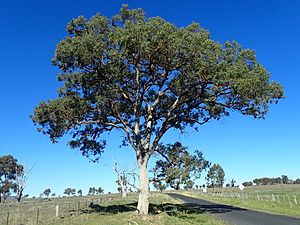Fuzzy box facts for kids
Quick facts for kids Fuzzy box |
|
|---|---|
 |
|
| habit near Yarrowyck | |
| Scientific classification | |
| Genus: |
Eucalyptus
|
| Species: |
conica
|
The Fuzzy Box (scientific name: Eucalyptus conica) is a special type of tree that grows only in eastern Australia. It gets its common name, "fuzzy box," from its rough, flaky bark. This bark covers its trunk and larger branches. Higher up, the bark is smooth. This tree has long, narrow adult leaves, and its flower buds are shaped like ovals or diamonds. These buds usually grow in groups on the ends of the branches. When it flowers, you'll see pretty white blossoms. After the flowers, it grows fruit that looks like a small cone.
Contents
What Does the Fuzzy Box Look Like?
The Fuzzy Box is a tree that can grow quite tall, sometimes reaching up to 20 meters (about 65 feet) high. It has a special woody swelling at its base called a lignotuber. This helps the tree regrow if it gets damaged, like from a bushfire.
Its bark is rough and flaky, usually greyish with some lighter patches. This rough bark covers the main trunk and bigger branches. However, the thinner branches have smooth, whitish bark.
Leaves and Flowers
Young Fuzzy Box plants and new shoots that grow after the tree has been cut (called coppice regrowth) have egg-shaped leaves. These leaves are about 4 to 8 centimeters (1.5 to 3 inches) long and 1.4 to 4.5 centimeters (0.5 to 1.7 inches) wide.
Adult leaves are a dull green or bluish color on both sides. They are shaped like a spearhead, about 5.5 to 14 centimeters (2 to 5.5 inches) long and 1 to 2.5 centimeters (0.4 to 1 inch) wide. Each leaf has a stalk, or petiole, that is about 0.8 to 2.3 centimeters (0.3 to 0.9 inches) long.
The flower buds usually grow in groups along a branching stem, which is called an inflorescence. Each small branch of this stem has seven buds. The main stalk holding these buds (the peduncle) is about 0.3 to 1.5 centimeters (0.1 to 0.6 inches) long. Each individual bud sits on a tiny stalk (a pedicel) that is about 0.2 to 0.6 centimeters (0.08 to 0.24 inches) long.
Mature buds are oval or diamond-shaped. They are about 0.4 to 0.5 centimeters (0.16 to 0.2 inches) long and 0.2 to 0.3 centimeters (0.08 to 0.12 inches) wide. Each bud has a cap, called an operculum, which can be conical, rounded, or even have a small beak shape.
Fuzzy Box trees bloom between July and December, and their flowers are white.
Fruit
After flowering, the tree produces woody, cone-shaped fruits. These fruits are called capsules. They are about 0.3 to 0.6 centimeters (0.12 to 0.24 inches) long and 0.3 to 0.5 centimeters (0.12 to 0.2 inches) wide. The parts that open to release the seeds (called valves) are usually level with the rim of the fruit or slightly hidden inside.
How the Fuzzy Box Got Its Name
The scientific name for the Fuzzy Box, Eucalyptus conica, was first officially described in 1900. Two important scientists, Henry Deane and Joseph Maiden, gave it this name. They published their description in a scientific paper called Proceedings of the Linnean Society of New South Wales.
The second part of its scientific name, conica, comes from the Latin word conicus. This word means "conical," which perfectly describes the cone-like shape of the tree's fruit.
Where Does the Fuzzy Box Grow?
The Fuzzy Box tree prefers to grow in areas with heavier alluvial soils. These are soils that have been deposited by flowing water, often found near rivers or streams. You can find the Fuzzy Box in grassy woodlands.
Its natural home stretches from near Wagga Wagga in New South Wales all the way up to the Northern Tablelands in New South Wales. It also grows in Carnarvon National Park in Queensland.
Images for kids





